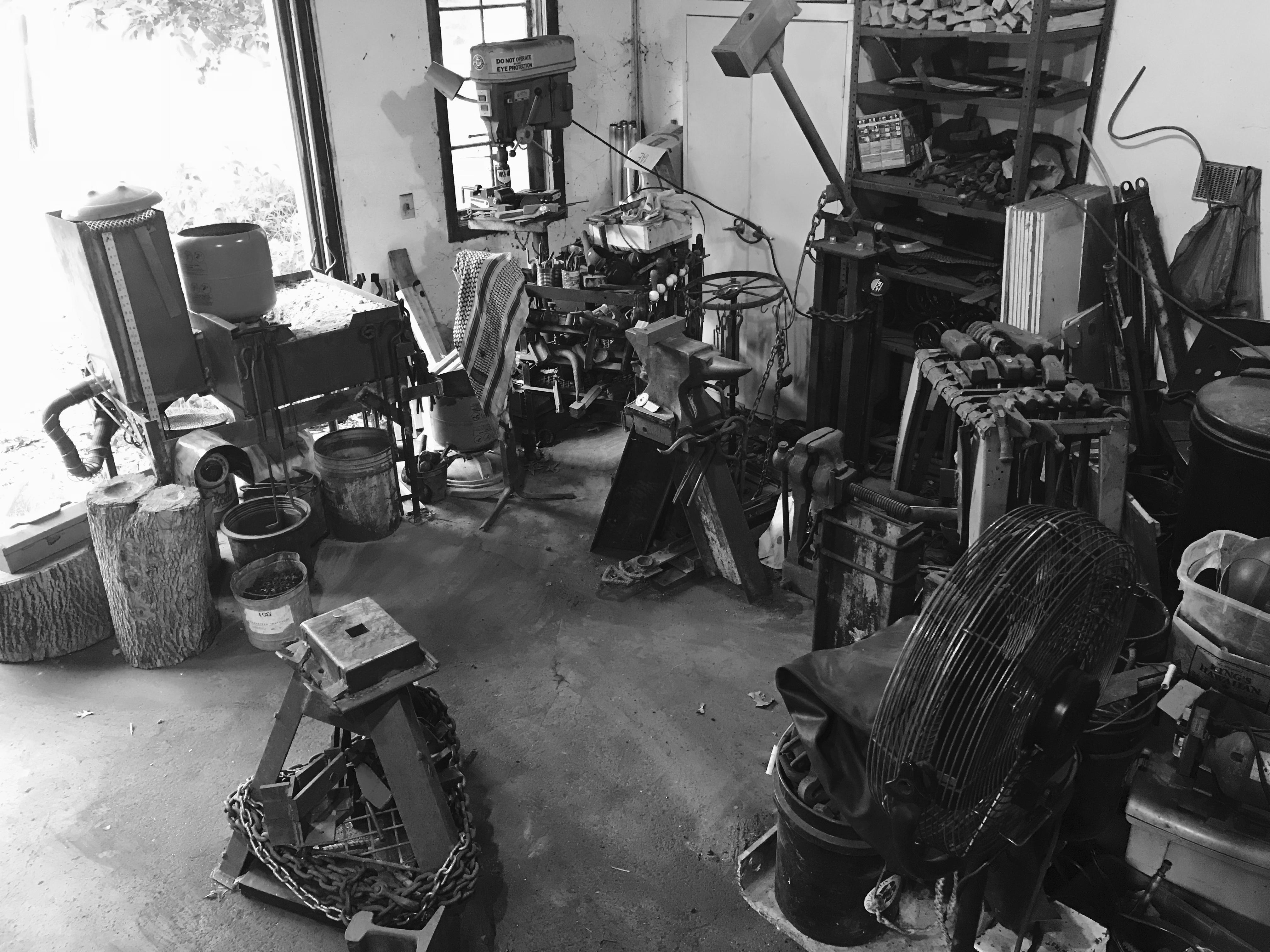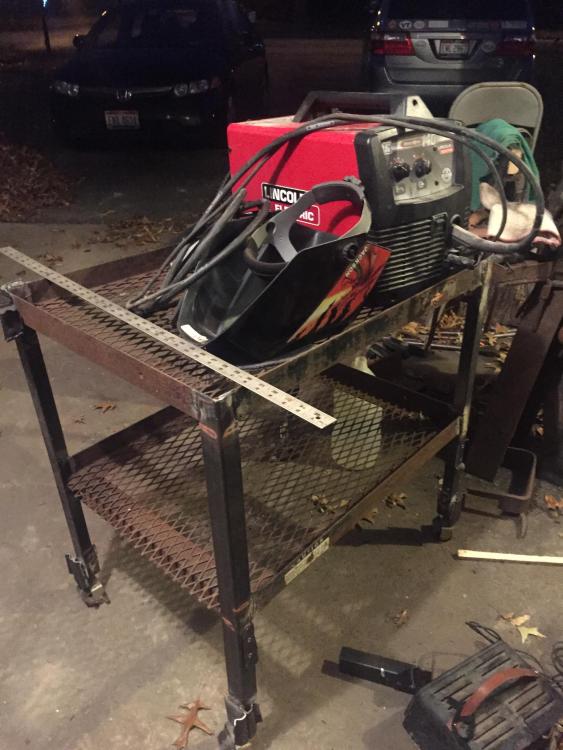-
Posts
19,403 -
Joined
-
Last visited
Content Type
Profiles
Forums
Articles
Gallery
Downloads
Events
Everything posted by JHCC
-

What did you do in the shop today?
JHCC replied to Mark Ling's topic in Blacksmithing, General Discussion
Or a stainless saddle plate. -
Nice!
-
I've gotten some great files for cheap at flea markets and yard sales. Look for ones that are gummed up with oil and nameless gunk but that are still pretty sharp underneath. Dirty files can be cleaned. Dull files can also be sharpened with an acid bath (or so I'm told; I've never had to try it myself).
-
I'm guessing repair: replacement of the bottom part of the movable jaw, the hinge plates, and the central section of the post. Is the bottom (more slender) part of the post welded on? If so, they may have replaced the middle part of the vise, keeping the jaws and the bottom of the post.
-

What did you do in the shop today?
JHCC replied to Mark Ling's topic in Blacksmithing, General Discussion
For example, I have a magnetic personality, and my middle just keeps getting softer as the years go by. There is no causal relationship between these two things. -

What did you do in the shop today?
JHCC replied to Mark Ling's topic in Blacksmithing, General Discussion
Well, these might be the hammers you use for forging stainless in future. -
If I were to hazard a guess, I'd suppose that the modification to the horn and the possible scarfing divot were made by the smith after purchase. As I understand it, most of the chainmaking in the Black Country was cottage industry, with lots of small shops doing piecework. In such a context, it's not hard to imagine a small shop modifying an existing anvil rather than investing in a specialized chainmaking anvil. But again, this is all supposition. Seek no further: here are the original JABOD thread and the one where I documented building my own.
-
Sharp, and properly shaped for the job at hand. Coarse files are good for basic shaping, and finer files are better for cleaning up a piece before you move on to grinding or sanding. Remember that the bigger a file is, the easier it is to hold at the correct angle.
-
Anvil price depends on a number of factors: condition, location, collectibility, size, and the current state of the market, just for starters. Your anvil looks to be in good shape overall, so that would bring the value up. However, it's had some specific modifications, which might bring the price down. You're in the UK where anvils are somewhat more plentiful, so that would tend to lower the price. There might be people collecting this particular manufacturer, but its value to a collector would probably be more on account of its size, use, and slightly unusual pattern. The size is quite desirable, so that would bring the price up. The market in the US is (as noted above) somewhat inflated, as TV shows have popularized bladesmithing in particular, and everyone and their dog thinks they should buy an anvil. In short, you got a good deal on a good anvil. Well done, you. Couple of things on this: first, you can get started smithing with comparatively few tools and build up from there. If you're going to spend money, spend it on TONGS. You can get a decent hammer for practically nothing at a boot sale, you've already got the anvil, and you can make a perfectly good forge for almost nothing if you go with solid fuel (see the threads about the JABOD and 55 forges) or comparatively little if you go with gas (see the Forges 101 and Burners 101 threads). The one thing that people never seem to grasp is that holding the workpiece is just as important as what you hit it on, what you hit it with, or how you heat it. Trust me, when you lose your grip on a piece of red-hot steel and it goes flying through the air, bad things can happen. I don't know how much smithing experience you have, but I (and others here) strongly recommend that you get your forging technique down before you start trying to forge a blade. Learning how the metal moves under your hammer is something that you can read about, but you'll only understand when you've done it. Take some time on learning basic hammer control and forging technique on some simple non-knife projects; you'll thank yourself later.
-

What did you do in the shop today?
JHCC replied to Mark Ling's topic in Blacksmithing, General Discussion
Every bit of material used in this (except the flux-core welding wire) came out of the trash. -

Anvil stands wood vs metal?
JHCC replied to Everything Mac's topic in Stands for Anvils, Swage Blocks, etc
I'm totally sold on the "heavy metal stand" concept now. If I had a dedicated shop space (rather than just part of my garage), I would definitely go with a metal stand bolted to the floor. -

What did you do in the shop today?
JHCC replied to Mark Ling's topic in Blacksmithing, General Discussion
Thanks, Mark. It's not quite finished (still have an idea for some tool racks to go on the side), but the basic structure is complete. Here's a little tip: When throwing together something like this, it's very easy for the feet to get out of whack and not sit flat on the ground. So, I welded on three of the legs, stood the thing upright, clamped the fourth leg in place with its caster touching the floor, and welded that on. The rest of the cart may not be square or level, but at least the feet are all in the same plane! One other detail -- there are only two critical measurements on the whole thing: the total height is 1-1/2" lower than the height of the anvil, and the bottom shelf has enough clearance for me to store the welder underneath. -

What did you do in the shop today?
JHCC replied to Mark Ling's topic in Blacksmithing, General Discussion
When someone lends you a welder, you weld something! (In this case, a work/storage table out of a trailer hitch cargo deck and some bed frame angle iron. Note the casters welded to the feet, which make it mobile.) -
No, this is theater *tech*, where the true masters of illusion have to turn wood, steel, canvas, foam, and paint into any setting you want, and still have it be safe and strong. You don’t mess with these guys.
-

Silicone Anvil Base Question
JHCC replied to MC Hammer's topic in Stands for Anvils, Swage Blocks, etc
Every single time. -

Twisted Damascus Short Sword with Cyprian Olive Wood
JHCC replied to TheoRockNazz's topic in Swordsmithing
I think you mean "Cypriot". Nice blade. I do like a low-count Damascus....- 4 replies
-
- twisted damascus
- short sword
-
(and 1 more)
Tagged with:
-
ABANA forbids anvil shooting, but I don't know if they say anything about putting your mandrel in orbit.
-
That could take your ring making to new heights.
-
That is two things: An ASO (Anvil-Shaped Object) Not worth your time or money
-

Silicone Anvil Base Question
JHCC replied to MC Hammer's topic in Stands for Anvils, Swage Blocks, etc
Just a quick once-over with a wire brush. You should be fine. -
I already have all the parts cut for the first three projects, so as soon as I can find some time, we're off to the races.
-
If I were in GA and had the wherewithal to pay $275 for a 100 lb Swedish anvil in good shape, I would definitely consider it (you might even try some haggling to see if the seller will take less if there's cash on the table). That's an excellent anvil, and 100 lbs is a good weight, especially if anchored solidly on a heavy stand.
-
The first is a Fisher, which is generally considered an excellent anvil. That one is in pretty bad shape, though. Welding is NOT recommended; you can really mess up the heat treatment of the top if you don't know what you're doing. Swedish anvils (especially the cast steel ones) are generally high quality, and one of these could be worth the investment. Please read Anvils: A beginner buyers guide; you will find this VERY helpful. Also, please add your general location to your profile settings. Anvil prices vary widely by region, and what looks like a decent price for one area might be exorbitant (or a total steal) for another. Welcome aboard!

